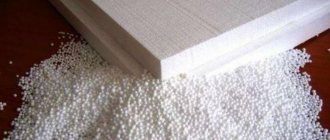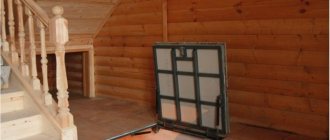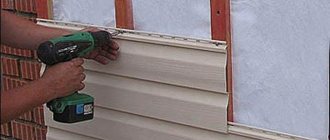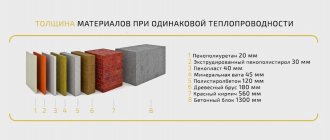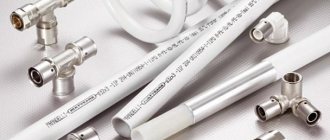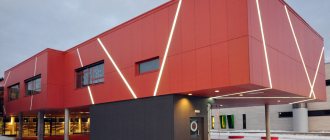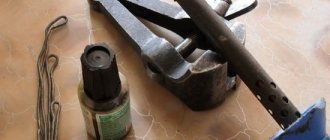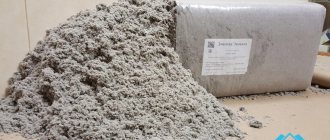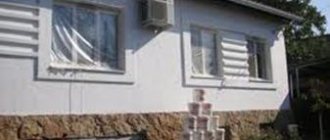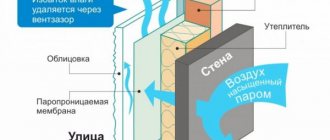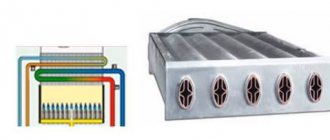What is thermal insulation plaster
New building materials that perform a specific task are also being developed in the field of building decoration. The main purpose of using heat-insulating plaster is to ensure thermal conductivity of no more than 0.175 W/m-K with a bulk density of up to 500 kg/m³. If this condition is not met, the material does not insulate heat sufficiently. Ideally, a plaster coating that retains heat should be an analogue of classic facade insulation, that is, it should be sufficiently strong, durable, and fireproof. The developers were able to solve the problem by replacing fillers that conduct heat well with components that have low thermal conductivity. That is, sand and stone chips in gypsum or cement compositions were replaced:
- expanded vermiculite;
- foam glass;
- sawdust;
- expanded clay;
- straw cutting;
- perlite, etc.
The result was various types of warm plasters that meet the specified requirements, which differ in their area of use:
- warm plaster for interior work;
- heat-insulating facade (for external use).
In addition, the compositions were modified, giving additional properties, resulting in heat and sound insulating plaster. This type of finish serves as both an acoustic and thermal barrier.
Thermal insulating compounds are used both for rough work (leveling) and for finishing.
Another class of components are modifiers. They are added to increase the lifespan, increase the elasticity of the solution, and prevent drying cracks. Manufacturers use proprietary plasticizers when creating mixtures. When making the composition with your own hands, detergents or PVA glue, ready-made modifiers available in construction stores, and microfiber are added to it.
Basic composition of plaster
Compared to other materials, it has low thermal conductivity. The basis of ordinary plaster is sand. Thermal insulation contains components that reduce its density and ensure the proper level of thermal insulation. The building material is based on binding components, the most common of which are gypsum, cement and lime.
The mixture is used for various purposes. Warm plaster for external use has a special composition: components are added to it that improve hygroscopicity. Gypsum and lime options are used for interior work. The universal product contains cement. Compositions of this type can be used for both exterior and interior decoration. Thermal insulating plaster for interior work, as well as a universal composition, are available in the form of powders. Before use they are diluted with water. Some builders prepare the bulk mixture themselves. However, it is recommended to purchase it from a reliable manufacturer.
Insulation is ensured due to the content of large additives in the product (they can be porous) and special fillers, which are most often used as sand, sawdust and glass.
Thermal insulating plaster includes water-repellent additives that release air. Antiseptic elements and plasticizers act as additional components. They are needed so that the mixture retains its properties.
Tests have shown: if the mixture is applied in a layer of 6 cm, thermal insulation will be provided as from two layers of brick. If winter is frosty, you should pay attention to this product. The mixture is applied to materials that allow cold to pass through. It can be used to seal gaps left after installing tiles.
Advantages and disadvantages of warm plasters
In order to reduce heat loss, various materials are used in construction: mineral wool, expanded polystyrene, etc. They are laid on the walls outside.
Compared with such home protection, warm compounds have the following advantages:
- simple application that a beginner can handle;
- the material is highly plastic, it can be used to seal hard-to-reach areas of structures;
- no surface leveling required;
- no special fastening is needed; surface wetting is practiced to improve adhesion;
- the use of mesh reinforcement not over the entire area, but at corners and to repair cracks;
- a high adhesion rate allows the composition to be applied even to a metal base;
- the material is microporous, which makes it breathable and helps dry the walls;
- fire safety of most compositions;
- an additional benefit is good sound insulation of the insulated room;
- resistance to biological damage;
- the coating is frost-resistant, not afraid of temperature fluctuations;
- environmental friendliness;
- use of waste for the production of plaster composition (reducing the polluting load on nature);
- does not crack from vibrations and does not change under the influence of UV rays;
- thin-layer application provides additional insulation when using mineral wool and other insulation materials.
Warm compositions have their disadvantages:
- the compositions are more expensive than insulation materials (taking into account the reduction in the cost of work and the reduction in costs for related materials, such as mesh, the cost is comparable);
- the increased dead weight of the coating with the additional load from absorbed water requires a strong foundation;
- a protective coating is necessary, since porosity promotes rapid absorption of moisture (compositions with foam glass and expanded polystyrene do not have this disadvantage);
- compositions with organic components (sawdust, straw) are limited in use (only indoors);
- The insulation layer is thick, so it takes a long time to dry;
- some fillers are flammable (polystyrene).
Advantages and disadvantages
Warm plaster has a number of advantages:
- Ease of use. The building material is easy to use. The bulk mixture is simply diluted with water and applied to the cleaned surface.
- Good thermal insulation. The mixture is used to create an additional layer of insulation; it is used to level the walls.
- Ease. This building material is lighter than regular plaster.
- Strength. If used correctly, it will not crack.
- Resistance to temperature changes. The mixture can be applied in both hot and frosty weather, but when choosing, you should take into account the climate.
- Resistance to mold. This type of plaster is not covered with fungal spores.
- Versatility. It can be used as an additional soundproofing layer.
- Environmentally friendly. Most types of plaster are not harmful to health, but some, particularly those containing polystyrene, may be harmful.
Like any building material , the mixture has some disadvantages:
- Incomplete thermal insulation. If you need to comprehensively insulate a room, it is recommended to combine the mixture with special materials.
- It is applied only in a thin layer. If you need to apply a layer of 5-6 cm, you need to strengthen the foundation.
- High level of water absorption. This is a significant drawback, to eliminate which it will be necessary to perform additional finishing with waterproofing decorative materials.
- If you plan to create a thick layer of plaster (more than 2.5 cm), you need to make reinforcement using a metal mesh.
Calculation of the thickness of the layer of warm plaster
To make such a calculation, use SNiP 02/23/2003.
Thermal conductivity of plaster is the ability of a material to conduct heat. If the room temperature is higher than the street temperature, then when the heating is turned off, the heat “leaves” outside through the walls (35%) and other structures. The intensity of heat loss depends on the area, thermal conductivity of the wall material, the difference between street and home temperatures, and other parameters. To quantitatively express the thermal conductivity of plaster coatings, λ is used - the thermal conductivity coefficient of the plaster (how much it is capable of conducting thermal radiation through an area of 1 m2, a layer 1 m thick with a difference of 1 ° C). For example, for plaster compositions the value of the coefficient λ in descending order (W/(m*°C)) is as follows:
- cement with sand – 0.93;
- cement-lime with sand – 0.87;
- lime with sand – 0.81;
- clay with sand – 0.69;
- gypsum – 0.35;
- clay with sawdust – 0.29;
- gypsum with perlite – 0.23;
- cement with perlite – 0.3.
The coefficient λ =1 means that the heat loss will be 1 W for a wall thickness of 1 m. If this figure is not 1 m, but 20 cm, then the heat loss will be 1: 0.2 = 5 W. If the temperature difference is not 1°C, but 6°C, then the losses will be higher: 5 x 6 = 30 W.
To determine the thermal resistance, use the formula R = d/λ, where λ (taken from the table), d is the thickness of the material.
For example, thermal resistance (R) for a foam concrete wall with a thickness of d = 51 cm
R=0.51/0.3=1.7 (m2*°K)/W.
From the table for external walls, take the standard value of their heat transfer resistance for the desired region. For example, for Moscow it is equal to 3.28 (m2*K)/W, which means that the calculated resistance of foam concrete in Moscow for the wall of a house is not enough. And for Sochi (1.79) too.
To calculate the thickness of the plaster coating (gypsum with perlite), determine the difference between the norm and the existing indicator Ra = Rм – Rst = 3.28 – 1.7 = 1.58 (m2*K/W)
With thickness d
R=d/ λ or d=R* λ
Using this formula we calculate d = Ra* λ = 1.58 * 0.23 = 0.363 m or 363 mm. We are not satisfied with a plaster coating of such thickness, so using insulation would be optimal.
For Sochi d= (1.79-1.7)*0.23 = 0.021 m or 21 mm. In this case, for the Sochi region, the thermal conductivity of the plaster (gypsum-perlite) is quite sufficient.
Types of heat-insulating mixtures for plastering
Thermal insulation compositions are classified by the type of binder: gypsum, cement, etc., as well as by the type of insulating filler.
Straw based
The material used for a long time is insulating plaster made of clay with straw grain. Straw in clay coating acts as reinforcement and creates voids.
As a result, the plaster coating can be thicker without delamination or cracking. It is applied as a rough layer on the wall over shingles by hand. The coating is breathable, absorbing excess moisture from the air and returning it when the room is dry. Before application, the walls are moistened or sprayed with clay mash. The main disadvantage is the long drying time. The main advantage is a favorable microclimate and low cost.
Sawdust based plaster
Sawdust has long been used for home insulation. They covered the rubble and ceilings. They were added to clay and lime mixtures for coating walls. Sawdust retains heat better than wooden beams, since the thermal conductivity coefficient of sawdust is 0.06 - 0.07 W/(m2•°C), and that of wood is 0.18. In terms of heat retention, sawdust is much closer to polystyrene foam.
Compositions with sawdust can have a different mineral base - clay, gypsum (Armenian plaster: 3 parts of gypsum, 1 part of sawdust), cement and lime. The main application is indoors. Before mixing the composition, sawdust is sifted through a sieve with a cell diameter of 5 mm.
Polystyrene as filler
A type of polystyrene foam - expanded polystyrene - is used for various purposes, for example, as a filler for anti-stress toys, upholstered furniture, and sleeping pillows. The material is ultra-light (up to 98% air), does not absorb water, and is not food for microorganisms. It is used in cement screeds for floor insulation (1:4:4 - cement/polystyrene granules/sand), and also as a heat-insulating leveling layer (1:3) laid under the screed.
Plaster mixtures with polystyrene are used for work on facades and indoors. They are produced on the basis of cement or cement with lime. Although they do not burn, they can release toxic substances when ignited.
Plaster mixture with the addition of foam glass
Small glass balls (up to 2 mm), which contain air bubbles that are not afraid of water, are perfect for use as a filler for warm plasters for facades. Such compositions are easy to install, retain heat well, and do not get wet.
Mixtures based on perlite, vermiculite and expanded clay
When volcanic lava frozen on the ground comes into contact with water, obsidian hydroxide is formed - porous round granules similar to pearls. Due to this, the hydroxide received the name pearlite. The granules have high porosity, which reaches 40%, and are capable of absorbing water 4 times more than their own weight (hygroscopicity is a disadvantage of such mixtures). For plaster composition (external and internal use), expanded perlite is more often used.
The mineral group of hydromicas contains vermiculite, consisting of small exfoliated scales of brown-golden color. When heated, vermiculite swells and fills with air. Used in lightweight concrete compositions and warm plaster mixtures. Has antiseptic properties. Perlite and vermiculite absorb odors and water well, so they need finishing plastering.
Expanded clay granules (crumbs) are produced by firing some low-melting types of clay. During firing, light, low heat-conducting granules of different sizes are formed. For warm facade plaster, granules up to 5 mm in diameter are used.
Economical plaster thermal insulation.
Polymer plasters can only be purchased; you cannot make them yourself. But it is more economical to mix solutions with mineral binders yourself.
Hiring hired workers is expensive. But, if you make the mixture yourself, the overall price will drop slightly. Many developers save in this way: they hire plasterers and do the “dirty” work for them. Considering that the help of a helper is paid not per m2, but per day, the savings may not be significant. Approximately 800-1200 rubles/day.
Even cheaper is preparing the wall yourself, placing beacons and rough plastering. The “specialists” will only have to level the coating and apply a decorative solution.
Thermal insulating cheap plaster for exterior use.
Insulating mixtures are more expensive than regular ones because they are more complex. Moreover, not everything can be done with your own hands.
However, the production of cement-based mortar is within the capabilities of any novice builder and can significantly reduce the cost of funds. As a filler, you can use both moisture-resistant bulk materials (foam glass, expanded clay sands) and non-moisture-resistant ones (sawdust, perlite, vermiculite). The latter are only protected with a layer of dense concrete.
For external heat-insulating plaster it is possible to use polystyrene fillers. The most economical filler is crushed polystyrene foam. Its cost is zero, it is free. If you use foam packaging for grinding.
This type of concrete is widely used in Russia and abroad. It is not dense and is not applicable in structures requiring high strength. But it is quite suitable for external insulating plasters.
Do-it-yourself thermal insulation plaster for interior work.
Developers pay less for a square meter of finishing without filler than for a mixture with filler. Therefore, some, especially “enterprising” builders, are trying to add insulating bedding to ready-made mixtures. This is prohibited: such manipulations greatly weaken the solution, reducing its strength and durability.
To reduce the cost per sq.
It’s easier to make the batch yourself using inexpensive fillers and binders. Thus, clay-sawdust mortar is practically free, although it is not inferior in strength to gypsum. data-matched-content-ui-type=”image_stacked” data-matched-content-rows-num=”2″ data-matched-content-columns-num=”3″ data-ad-format=”autorelaxed”>
Basic rules for applying warm plaster
To make a truly heat-insulating plaster screen, you need to follow certain rules:
- It is important to properly prepare the foundation.
- To mix the dry mixture (SS), take the amount of water according to the instructions.
- In a large container, mix the entire volume contained in the package with water, so it is guaranteed that each portion will contain the required proportion of components.
- The SS is poured into the poured water, being careful not to create dust. The mixture is stirred for 5 minutes with a mixer at low speed (areas close to the sides and bottom are treated). Then give the solution 5 minutes to “ripen” and stir for another 2 – 3 minutes.
- Work quickly, trying to use up all the solution before the end of its life. A solution that has begun to set for application to the wall is unsuitable.
- Work is carried out at temperatures above +5°C, below +30°C. Drafts, direct exposure to sunlight and rain are not allowed. During facade work, a canopy is made.
- Before plastering, turn off the power to sockets and switches.
- Use safety glasses to protect your eyes.
- Used beacons are removed after applying the solution. You cannot leave them in the wall, as they serve as cold bridges.
- The use of primers is necessary to ensure adhesion sufficient to hold a thick plaster coating on the wall.
- The insulating layer should be no thicker than 25 mm. If greater thickness is required, apply several layers intermittently to dry. The surface of the overlapping layers is not smoothed for better adhesion.
What types of decorative plaster are there?
All plaster mixtures differ in the type of base, texture, viscosity, and color scheme.
As a rule, decorative plaster consists of a water base, binding elements, fillers, and additives. Depending on its composition, it is classified into several types.
Mineral
The main element of the base is cement, which is supplemented with crumbs of valuable stones: marble, granite, malachite.
Mineral plaster is produced in dry form. Before applying the decorative layer, the powder must be diluted with water and mixed thoroughly. As a rule, there are no problems with application. The wall is covered with a thin layer, so it requires more careful preparation: grouting cracks and eliminating irregularities. This is due to low elasticity - if you apply a layer thicker than indicated in the instructions, the plaster may simply crack.
The main advantages of this type of decorative plaster are durability and environmental friendliness, so it can be used both for exterior decoration and for decorating children's rooms. It can often be found in bathrooms and restrooms, as it is resistant to temperature changes and high humidity.
The porous surface attracts dust and dirt well and can be difficult to clean. Therefore, it is better to choose plaster with a finely porous or smooth structure.
Pros:
- Excellent imitation of natural stone
- Resistant to humidity and different temperatures
- Environmental friendliness
- Durability and reliability
- Low cost
Minuses:
- Requirement for pre-finishing
- Durability (service life up to 10 years)
- Low level of ductility
Acrylic
The most versatile version of decorative plaster based on acrylic resins. It is sold ready-made, and the desired color can be obtained by adding any coloring pigment.
The plaster dries quickly and does not spread due to its high ductility. Acrylic plaster can be used to renovate not only living rooms, but also kitchens and bathrooms. It is not afraid of excessive humidity, mechanical damage and contamination. With good care, this finish can last about 15 years.
Among the disadvantages are poor vapor permeability, which can cause condensation to accumulate on the walls. In addition, plaster burns well, fades and cracks in direct sunlight.
Pros:
- Wide variety of colors
- Fast drying
- No need for painting
- Long service life
- Resistance to humidity and temperatures
- Easy care
Minuses:
- UV instability
- Low vapor permeability
- Easy to ignite
- Higher cost
Silicate
Potassium glass is used as a binder, which makes silicate plaster the most durable of all decorative types. It has a high degree of adhesion and increased resistance to moisture, temperature fluctuations and ultraviolet radiation, and repels dirt and dust. Silicate solution is an excellent antiseptic. It protects the surface from the growth of microbes, fungus and mold. The use of such plaster increases the fire resistance of the entire building due to the non-flammability of the material.
But this also affects its environmental friendliness. It is not recommended to use silicate plaster for interior wall decoration, as it is hazardous to health. An ideal field of activity is finishing the facades of a house.
When applied, the material hardens quickly, so you need to act quickly. Many manufacturers provide a guarantee of 20 to 50 years of operation.
Pros:
- Resistance to humidity, ultraviolet, temperature
- Increased strength
- Long service life
- Fire resistance
- Pest resistance
- Easy care
Minuses:
- Curing speed
- Suitable for exterior use only
- Not environmentally friendly
Silicone
Such plaster has long been considered as the best and most practical option for finishing an apartment. Silicone resins and additional antifungal additives included in the material give it a lot of advantages.
The plaster fits perfectly on any surface: brick, concrete, drywall. Before application, the wall must be coated with a primer; the plaster itself does not need to be thinned - it is sold as a ready-made mixture. This eliminates possible mistakes when mixing, and it is easy to apply due to its elastic structure.
Silicone plaster “breathes”, is easy to clean and does not deteriorate under the influence of moisture and UV rays. The dried surface does not crack even with mechanical damage. This finish will last more than 20 years, even in a house where there are pets and children who like to use the walls for other purposes.
Pros:
- Long service life
- Increased strength
- Resistance to ultraviolet radiation, humidity, temperature, mechanical damage
- Easy care
- Easy application
- Increased elasticity
- More than 6000 color variations
Minuses:
- High price
Another classification is carried out according to the texture component of the material. Depending on the modeling effect, the following types of decorative plaster are distinguished.
Structural
During production, different-sized fibers and granules are used, which create a certain structure on the surface. The wall turns out to be rough, and the degree of unevenness can be completely different - it depends on the size and shape of the additives used.
Different tools will help you create absolutely any drawing. Various sponges, rollers and spatulas are used for application. The downside of this finish is that the walls look rather rough.
Depending on the different components of the mixture and application techniques, you can create unique types of coatings:
- "Brick"
- "Bark beetle"
- "Lamb"
- "Latex plastic"
- "Terrasite"
- "Graffito"
- "Painting"
Textured
Most often, for the renovation of residential premises, textured plaster is used, which is absolutely safe for humans, is not subject to fire and moisture, and can turn the most ordinary interior into an exclusive one.
Textured plaster is produced in two forms: in plastic buckets and in powder form. In the first case, the material is completely ready for use, in the second, the powder must be diluted with water and the solution must be mixed.
Various additives included in the plaster create a unique texture for the walls and realistically imitate wood, velvet, silk, leather, and stone. They are especially popular in the decoration of restaurants and offices.
The most popular textured plaster patterns are:
- "Fur coat"
- "Bark beetle"
- "Travertine"
- "Silk"
- "Concrete"
- "Tree"
- "Brick"
Venetian
Venetian plaster was used by thrifty architects in ancient Rome. It was they who came up with the idea of mixing slaked lime and dust to create a unique material for finishing rooms. Using natural dyes, it was possible to decorate the interior from “fictitious” marble of any shade, which made boring chambers worthy of the emperor himself.
Despite the fact that hundreds of years have passed, an identical composition is still used today. However, applying Venetian plaster requires certain skills - different movements create a unique pattern. What will happen is difficult to predict. And such plaster costs a lot.
Walls covered with Venetian plaster look aesthetically pleasing, have no seams and are highly reliable. It does not wear out, does not crack even with mechanical damage and can withstand extreme temperature ranges - from -50 to +80 degrees.
There are some types of decorative plaster for interior wall decoration, in the photos of which you can see real luxury.
- "Craquelure". The effect of a cracked wall is obtained by first painting the wall with white paint and finally drying the plaster with a hairdryer.
- "Carrara marble". Characteristic shimmers are achieved by applying two layers of plaster of barely distinguishable tones.
- "Veneto". The semi-matte effect of real marble adds sophistication to the room.
- "Marseille wax". An ideal solution for the Provence style in the interior - a special application technique creates a deep “antique” relief.
- "Wet silk" The smallest particles of silk and mother-of-pearl create a soft interior with notes of silk-screen printing.
- "Marbello". The imitation rock looks unusual due to the shimmer in the light.
- "Trevignano". Velvet and gloss together look as expensive as possible.
- "Encausto." The final coating with wax creates the effect of granite.
Flock
A relatively new type of finish that, after drying, resembles flowing silk. The room looks stylish and elegant.
The main components are silk fibers, cellulose, minerals and dyes. Sometimes flock plaster is called “chips”, since one of the modeling fillers is small acrylic plates.
The moisture-resistant and waterproof coating retains its appearance for many years. You can even decorate the walls of a nursery with it, since the flocks will survive any blows, scratches and are absolutely non-toxic to humans.
Flock plaster can be:
- Mother of pearl
- Monochrome
- Multicolor
- Metal
- Fluorescent
- With flakes of different shapes and sizes
- With glitter and sequins
In addition to the richness of reliefs and patterns, decorative plaster offers a wide range of colors. Many formulations are sold initially unpainted. To get the desired shade, you can purchase additional coloring paste separately and create the design of the room to your taste.
Making warm plaster with your own hands
Commercially available CCs are not cheap. There is an alternative. Craftsmen prefer to create warm plaster solutions with their own hands. All components can be purchased for almost nothing. Clay or lime can be used as a natural plasticizer. Liquid soap is also suitable, which is added at the rate of 2 - 3 spoons per 20 liters of mixture. You can purchase a hydrophobizing agent in the store (use according to the instructions).
We offer you several recipes for thermal insulation compositions.
Recipe 1. Mixture for facades:
- 1 part – cement from M400;
- 1 part – foamed polystyrene 1 – 3 mm;
- 3 parts perlite;
- 50 g – polypropylene fiber;
- plasticizer (add according to instructions).
Mix the dry ingredients and add enough water so that the solution has a paste-like consistency and does not run off the trowel.
Recipe 2. Indoor mixture:
- 1 part – white cement M400;
- 4 parts – filler (vermiculite or perlite);
- 50 g/bucket of cement - PVA glue or factory plasticizer (adhere to the proportion recommended by the manufacturer);
- water.
Recipe 3. Thermal insulation from perlite-sand mixture:
- 1 volume part of cement;
- 1 part sand;
- 4 parts perlite.
Recipe 4. Warm composition with sawdust and paper (for rooms and facades):
- 1 part – cement;
- 2 parts – paper pulp, soaked into porridge;
- 3 parts – sawdust;
- water.
Recipe 5. Lime-sawdust composition:
- 1 part sawdust;
- 10 – 15 parts of dry slaked lime;
- Water.
Lime is a strong biocidal agent that is not attacked by rodents, mold and mildew. Quicklime cannot be used with sawdust, since mixing produces a lot of heat. The solution has a short lifespan, so it needs to be produced quickly. The dry ingredients are mixed, then cement or other binder is added (if desired). Water is added last.
Recipe 6. Clay with sawdust and straw (for walls):
- 1 hour – clay;
- 2h. – sawdust (or sawdust with straw).
For ceilings and floors the proportion is 1:10. The solution has no shelf life, as water is simply added if necessary.
Video about preparing and applying warm plaster
Advantages of warm plaster for facades
Since the plaster is made from affordable and common components, its price will be correspondingly low. Also, a huge advantage over other insulating materials is its environmental friendliness, thanks to which you will not have health problems, especially for people suffering from allergic reactions, who are not recommended to use synthetic materials that do not allow air to pass through well, thereby creating problems.
Previous
Next
Do-it-yourself technology for applying warm plaster
preparing the solution
first layer
second and subsequent layers
finishing coat
- The wall is moistened with a spray bottle.
- The mortar is applied in a layer of up to 1 cm with a trowel or spatula, pressing the mortar mass against the wall to increase adhesion. This primary layer is not smoothed over. If the coating thickness is large, a recessed reinforcing mesh is applied to this layer.
- The second and subsequent main layers (primer) are applied up to 2.5 cm thick. They are leveled (without trying to make them smooth) using a grater.
- When the total thickness of the coating reaches 4 cm, a second reinforcing mesh is applied. The edges of the mesh sheets are overlapped with an overlap of 10 cm.
- When the entire volume between the beacons is filled, the surface of the top layer is leveled by the rule.
- After the top layer has set, the beacons are removed and the remaining grooves are filled with solution.
- After the solutions have completely dried, a finishing finish is applied over the rough coating.
Work on the reinforcing layer
The reinforcing plaster layer is intended for internal strengthening of a thick coating, applying it to the facade insulation, at the joints of layers with different shrinkage characteristics, as well as in the case of plastering a building before its shrinkage is completed. For example, a reinforcing layer is made where part of the wall is made of gas silicate blocks, and part of it is made of brick. This section of the plaster coating must be reinforced. It is carried out using a plastic or fiberglass mesh, which has sufficient strength and is not afraid of the internal alkaline environment of the insulating plaster coating. Reinforcement work is carried out inside the solution. A layer of the mixture is applied to the ceilings and walls, then the mesh is laid out and recessed. On the facade walls on top of the insulation, the reinforcement work is slightly different. First, the solution is applied in strokes, then the mesh is attached, and then plastered. They work with spatulas and polishers. When the layer has dried, apply the next one on top of it in the usual way.
Manufacturers and prices
The list of companies and the thermal insulation mixtures they produce is long. Popular ones:
- Umka UB-21 (Ecotermogroup company) is a warm plaster made of lime, cement, sand and foam glass for the northern regions, which requires finishing. With reinforcement, up to 10 cm is applied. Other insulating mixtures are UB-212, UF-2.
- Cement Knauf Grűnband is made with expanded polystyrene. The permissible layer is up to 30 mm.
- Unis Teplon has a gypsum-perlite composition that does not require finishing.
- Au Benputz Perlit based on Portland cement with perlite filler. You can't do without finishing.
- The Teplolux DeLuxe cement mixture retains heat using foam glass. It is also not final.
- Thermo Um is universal - used for facades and rooms. The mixture is hygroscopic.
Prices vary. On average, the price of 1 kg of dry mixture ranges from 11 to 21 rubles.
As practice shows, for the main areas of our country, heat-insulating plaster is not yet a panacea. However, its use allows not only to reduce heat loss, but also to reduce the noise level in the premises. For the southern regions, it is an excellent option for insulating houses.
